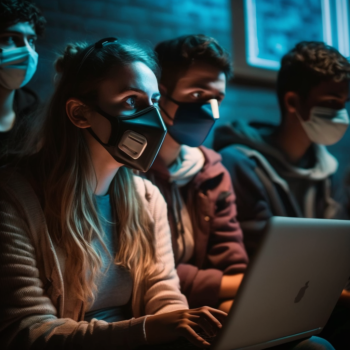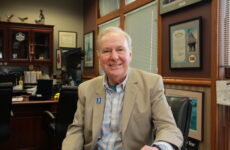
Photo illustration courtesy Midjourney
Although COVID rates have been declining, the pandemic has had a lingering effect on higher education, which along with most other schools, was forced to go mostly virtual in March 2020. DMACC would not resume full face-to-face classes until Fall 2021.
DMACC Ankeny Speech Professor Karen Christiansen says she has been giving students more grace and patience when turning assignments in, understanding that there is a lot of pressure added onto them.
“I take more late work than I used to. I think this is directly tied to the pandemic, because of the amount of leeway professors gave to their students,” Christiansen said.
During the height of the pandemic, students had to adapt to online learning, figure out how to connect with their peers, and face the fear of the unknown, all while trying to be academically successful.
Because students and professors had to switch learning modalities overnight, this has affected how many professors have adapted to the needs of their students.
Some students, once they switched to more online and virtual learning have not looked back, and have enjoyed every step along the way. Others think it is a nuisance and want to build that in-person connection again.
Newton resident and business student at DMACC Taylor Danley highlighted how he felt about the switch to remote learning.
“I adjusted to online learning because I had to, but this was more of an inconvenience for me because I prefer in-person learning. I am more of a hands-on learner and pride myself on being teachable,” Danley said.
Danley said however that the disruption caused him to take a step back and reflect on what really mattered to him.
“I really started figuring out other ways to grow outside of school. Honestly, the pandemic helped me more as a person because I was able to step back and zone in on life. But I still feel bad for my senior class of 2020, because we missed out on so much,” he said.
The COVID-19 pandemic caused a disruption in the real-life connection between students and professors. Colleges went virtual, which meant no more face-to-face interaction, which made it harder to create a rapport between professors and students.
English Professor Ann Kiesel at the DMACC Boone Campus says that a lack of face-to-face connection really hurt the relationship-building aspect between her and her students.
“Switching to virtual classes as an older higher education instructor was a huge learning curve for me. There were more distractions for students at home and sometimes the connectivity of students or professors would be lost,” Kiesel said.
Kiesel also stated that many students were suffering from mental health problems due to the pandemic. She focused on how students were impacted emotionally by everything that was happening.
“The pandemic decreased many students’ motivation and increased their anxiety; we have seen a lot of students drop out because of that. Deadlines are important but as professors, we also need to be good listeners, because there is a lot of anxiety out there,” she said.
Kendra Schmitz, a junior at Drake University, said it was difficult to manage the workload when going back to in-person school.
“It was hard going from a full schedule to doing nothing all day, every day. It did not feel like a holiday or summer break. I did not have assignments again until August 2020 when I started college. It was even harder going from not having any assignments to do for months to having tons of assignments for hard classes,” Schmitz said.
Schmitz also said that she began procrastinating and getting into some bad habits. This caused her grades and mental state to deteriorate.
“I found myself pushing assignments until the very last minute and lost motivation easily. My work ethic was gone. I also did not pay much attention in my virtual classes because there were no attendance requirements,” she said.
This sudden disruption to Schmitz’s normal routine caused her grades to suffer and she was not her normal self.
“My grades took a drastic hit, and I would get fatigued after an hour or two of schoolwork, unlike in high school,” she said.
Schmitz also stated that the option to go to virtual learning was critical during the height of the pandemic and appreciates how professors have been more flexible.
“Professors and universities have gotten better about dealing with student illness. When I had the flu last spring and couldn’t go to class, my professors were very understanding and allowed more flexibility with assignments,” she said.
Of course, after spending a year or two alone away from big crowds and formal in-person settings, it takes time for people to adjust to their regular pre-pandemic routines. One positive aspect of going through this was that people adjusted to online learning and still have that option today.
However, students are still adjusting to face-to-face classes. English professor Marc Dickinson from the DMACC Ankeny campus says he has noticed a difference from before the pandemic up until today, in how his students have adjusted to coming back into the classroom.
“I feel like when students come into class, they’re rusty. Even teachers are rusty. In my class, there isn’t as much participation as opposed to the past,” Dickinson said.
Dickinson also stated that as face-to-face enrollment went down, online enrollment went up. He feels as though students these days are more comfortable with the online format of learning.
“People have their own decisions on whether they want to do in-person or online classes. I am more dependent now on discussion boards. There is a barrier with in-person classes and the pandemic is a little to blame for it,” he said.
On the one hand, students have access to more classes that might not be available in person. On the other hand, students might feel frustrated that not enough classes are being offered in person.
Speech, English, and Journalism Professor Aimee Langager at the DMACC Urban campus feels that the flexibility and accessibility of classes have been beneficial for students all over the state.
“The pandemic has allowed for more flexibility in scheduling and increased access to classes. Having different modalities and virtual classes has been great for students who need options to work around work,” Langager said.
Services that used to be only face-to-face are also being online more since students aren’t on campus as often, Langager said.
“There were more online advising appointments being set up, students were getting help from the Academic Achievement Center, which was great. It can be difficult sometimes getting students the resources they need if you take away the face-to-face environment,” she said.
One of the biggest changes in higher education since the pandemic hit was the switch to online, remote learning. This appears to be the direction a lot of students and professors will take as we go into the future.
Professor Christiansen said she believes that going to a hybrid model of learning might not be the best choice for making connections with students and faculty.
“There is power in community, I feel like the networks you can make and build during college years are really important still. I feel that is what is tricky right now about higher education because it is leaning more toward a hybrid way of learning,” Christiansen said.





Comments